As an Amazon Associate I earn from qualifying purchases.
When you first start selling on eBay everything is new and overwhelming.
I know that when I started I felt like I spent as much time trying to figure out how to do things as much as actually doing them. In fact, I remember several times when I would become so obsessed with figuring out how to do something (optimize my eBay listing titles for example) that I wouldn’t get anything at all listed that day.
Luckily, eBay really isn’t that complex and most people are able to figure things out without a couple of weeks.
Which is the problem. Most people think they have figured out the reselling business and so they stop learning/growing.
Even people who are trying to grow their businesses just keep doing the exact same thing every day and seem to think that the real key to growing their eBay business is simply to work harder. While I’m not knocking hard work, if your business isn’t growing it might be time to look at your methods and processes and see if they need a little bit of tweaking.
Over the past year, we’ve significantly changed how our listing flow works so I thought I’d share a few ideas that you can implement.
While none of these are revolutionary or groundbreaking, if you are already selling clothes on eBay these tips and tricks should put you on a path to increased growth!
Best Tips & Tricks For eBay Sellers
1. Define Your Business Model
I see far too many sellers who commit to buying and flipping only high-quality items.
However, when they have a slow sourcing day at a thrift store, they end up buying a cartload of crap just so they don’t go home empty-handed. The roads to success are typically either quantity or quality and people who are consistent over time seem to do better. To that end, choose a business model and stick with it.
There are companies on eBay with over 1 million clothing listings. However, their average sales price (ASP) is typically around $10, they have a massive amount of overhead, and they hire dozens of employees just to keep on top of things.
If that doesn’t appeal to you, make sure you’re picking up only high-quality items that will keep your ASP (average sale price) up. It is possible to make six figures a year as a solopreneur with the quality approach, but not with the quantity.
2. Diversify Where You Source
If you want to grow a large and profitable eBay business, you have to eventually move away from thrift store or yard sale sourcing. Right from the beginning, I recommend trying to source on a larger or more consistent scale. Even if you aren’t able to buy large liquidation lots, you’ll gain the network, experience, and process to be able to do it in the future.
If you’re unsure about how to up your sourcing game for selling online, check out this article: Get Over The Thrift Store.
3. Work Out Bottlenecks
For me, taking pictures of items is the bottleneck when it comes to getting my inventory online.
I can source, I can measure, I can list, but for some reason, my pile of things that needs to be pictured is always on the verge of taking over my eBay room.
Remember, even if you’re a Poshmark seller, the purpose of your pictures is not to convince the buyer looking at it how cute it is. Make it appealing for sure, but do your best to communicate what the item actually looks like.
We now have a standard process we follow for every item, which keeps us moving.
Once you have your method set up, don’t change it. I know people who have to decide exactly how they’re going to photograph something every single time, “Mannequin….no….flat-lay….no….model….not…..hanger? Yes, a hanger. Let’s set up the hanger stuff.”
Just pick something and stick to it.
4. Don’t Have A Huge “Death Pile”
It’s named that way for a reason, and death piles are nothing but a sign of laziness.
Anyone can source cool stuff, but your sales are where the rubber meets the road. If it’s not listed, it can’t sell and isn’t profitable. With that being said, everyone has some level of death pile. Keep yours organized, hang up the clothing, and list everything in the order it comes in.
The most important thing that I’ve done in controlling my death pile is simply to stop buying stuff that I know I won’t list any time soon.
There are some items that I just absolutely hate taking pictures of but I feel like I have to buy them because it’s my duty to the profit-gods. Remember, you work for yourself as an eBay or Poshmark seller. If you don’t want to sell, save your money for something that excited you more!
5. Don’t Ship Daily
You can’t do every part of your business every day if you’re going to do things well.
We’ve narrowed our eBay tasks down to 4 categories: sourcing, listing, shipping, inventorying. We choose only two per day to focus on. Because of this, we have 3 days of handling time and ship every other day.
6. Focus On Monthly Listings
My beef with the “daily listing” mantra has been a bit of a theme lately on the blog but I feel like it does a lot of people a disservice.
There is so much chest-beating about the importance of listing daily that people feel like they’re failing if they don’t. If you need a goal that strict to make sure you get stuff done, go for it. Otherwise, the amount you list per month is far more important.
We’ll spend several days in a row sourcing, and then list $5,000 worth of inventory over a day or two. Having the inventory for sale is just as effective, no matter when it goes live.
7. Plan For the Long-Term
Remember, long term consistency beats short-term intensity.
If you want to burn out as a reseller, try to list 40 items a day for a month. Could you do it? Probably. Would you ever want to hear the name “eBay” again? Probably not.
If we decide to start growing our store it’s a long-term goal and it can take a month or two just to get your total number of items listed up by 100.
8. Align Your Actions With Your Goals
Most new resellers have unrealistic goals, we certainly did. We sold $50,000 worth of inventory our first year and want to double it the next year…and then the next year.
The problem is that we, like most resellers, reached a plateau within the first 2 years on eBay.
I personally can’t consistently maintain more than 1,800 listings unless I hire help. If you have a goal to net $100,000 per year, make sure your plan makes sense. You only have so many hours in a day, after all.
9. Separate eBay From Your Life
Get a storage unit, and if possible, a workspace. When we first started on eBay, we kept our listed inventory in a cupboard under our kitchen island. Then in a spare bedroom. We really had no concept of how to grow a reselling business and, because of that, eBay took over our house and life.
If you want to run a legitimate flipping business, keep eBay out of your personal life as much as possible. That means a separate eBay bank account, a storage unit for inventory, not constantly listing things when you’re with family/friends, etc.
Conclusion
Now that you’re armed with both brand knowledge and practical business-building knowledge, you’re ready to take on the world of flipping at a higher level.
People will tell you that 2022 is too late to build a business on eBay, but if you’re dedicated, consistent, and able to adapt, it is one of the few places left where you can be making $100,000 next year with no skill or knowledge beforehand.
So get out there and get flipping!







